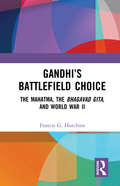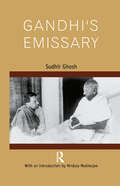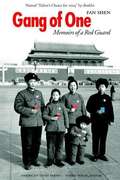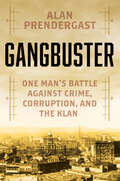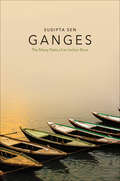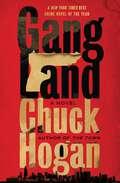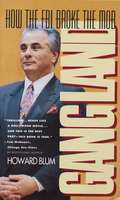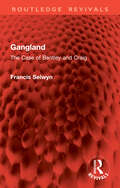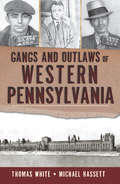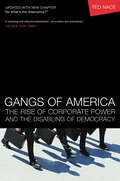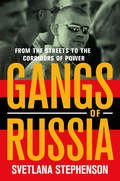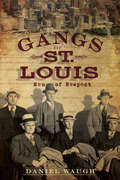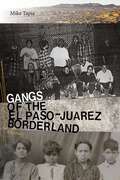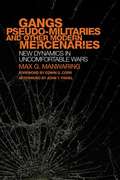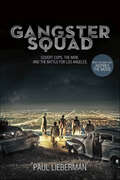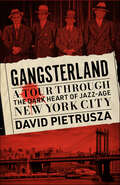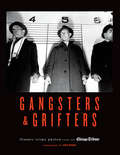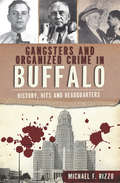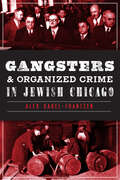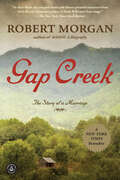- Table View
- List View
Gandhi’s Battlefield Choice: The Mahatma, The Bhagavad Gita, and World War II
by Francis G. HutchinsThis much anticipated volume compares and contrasts Gandhi’s non-violent leadership during World War II to the military leadership of Arjuna in the war that prompted the Bhagavad Gita dialogue, the Sanskrit text that guided Gandhi’s actions throughout his life. Early in his career as leader of India’s campaign to end British rule, Gandhi resisted terrorist interpretations of the Gita and described the Gita as depicting a metaphorical battle between good and evil impulses within every human heart. Then when India was drawn into a world war not unlike that in which Arjuna reluctantly led his troops into combat, Gandhi embraced his role as battlefield commander of the millions he had trained to be non-violent warriors. Never abandoning his dedication to non-violence, Gandhi stressed to his recruits that they should act as non-violently as possible but should not passively accept injustice. Remaining true to the Bhagavad Gita while responding to urgent hazards affecting all Indians, Gandhi himself became a wartime battlefield commander leading millions in the climactic Quit India conflict that ended British rule. <P><P>The volume provides an overview of Gandhi’s entire career as leader of the Indian Nationalist Movement, clarifies Gandhi’s approach to acting non-violently when surrounded by violence, and affirms Gandhi’s enduring importance as a source of inspiration around the world. P><P>Please note: Taylor & Francis does not sell or distribute the Hardback in India, Pakistan, Nepal, Bhutan, Bangladesh and Sri Lanka
Gandhi’s Emissary
by Sudhir GhoshIn 1946, at the age of 29, the author was chosen by Mahatma Gandhi to act as unofficial emissary between the British Labour Government and India in the delicate negotiations which resulted in the country’s independence. His unique position enabled him to give the world a moving and informed account of the principal actors in the drama that led to the division of India and Pakistan and the creation of a parliamentary democracy in India. With the resurgence of interest and debate on Partition in India and Pakistan, and around the world, in the context of current international groupings, it is fitting that this book be brought back into circulation.
Gang of One: Memoirs of a Red Guard
by Fan ShenIn 1966 twelve-year-old Fan Shen, a newly minted Red Guard, plunged happily into China's Cultural Revolution. Disillusion soon followed, then turned to disgust and fear when Shen discovered that his compatriots had tortured and murdered a doctor whose house he'd helped raid and whose beautiful daughter he secretly adored. A story of coming of age in the midst of monumental historical upheaval, Shen's Gang of One is more than a memoir of one young man's harrowing experience during a time of terror. It is also, in spite of circumstances of remarkable grimness and injustice, an unlikely picaresque tale of adventure full of courage, cunning, wit, tenacity, resourcefulness, and sheer luck--the story of how Shen managed to scheme his way through a hugely oppressive system and emerge triumphant. Gang of One recounts how Shen escaped, again and again, from his appointed fate, as when he somehow found himself a doctor at sixteen and even, miraculously, saved a few lives. In such volatile times, however, good luck could quickly turn to misfortune: a transfer to the East Wind Aircraft Factory got him out of the countryside and into another terrible trap, where many people were driven to suicide; his secret self-education took him from the factory to college, where friendship with an American teacher earned him the wrath of the secret police. Following a path strewn with perils and pitfalls, twists and surprises worthy of Dickens, Shen's story is ultimately an exuberant human comedy unlike any other.
Gangbuster: One Man's Battle Against Crime, Corruption, and the Klan
by Alan PrendergastA gripping and exhaustively researched, first-time account of a feared gangbuster&’s groundbreaking battles with organized crime, the KKK, and corruption at the highest levels of government sure to resonate with readers affected by the politics of contemporary society. At the height of the roaring 1920s, the ex-frontier town of Denver, Colorado, emerged from the postwar boom as the future of the American city. But the slick façade of progress and opportunity masked a murky stew of organized crime, elaborate swindles, and widespread government corruption. One man risked everything to alter the course of history. Rookie district attorney Phillip Van Cise was already making national headlines for a new brand of law enforcement. Employing military intelligence tools he&’d developed during the Great War—wiretapping, undercover operatives, communication intercepts—Van Cise crippled the criminal empire of Lou Blonger, an ex-lawman who had risen from petty scam artist to master of the Big Con. But Van Cise had even darker, more malevolent forces on his radar. The Ku Klux Klan had emerged as a shockingly mainstream middle-class movement, employing anti-immigration scare tactics, encouraging vigilantism, and instigating culture wars, all while claiming to protect true American values. Van Cise saw the toxic ideology for what it was: a new version of the Big Con sold as populism. Utilizing his pioneering surveillance techniques, Van Cise was determined to expose the Invisible Empire from within. Gripping and exhaustively researched, this prescient chronicle of Phillip Van Cise&’s spectacular career as a feared gangbuster taking on organized crime, the KKK, and corruption at the highest levels of government is a cautionary tale that mirrors our tumultuous times.
Ganges: The Many Pasts of an Indian River
by Sudipta SenA sweeping, interdisciplinary history of the world’s third-largest river, a potent symbol across South Asia and the Hindu diaspora Originating in the Himalayas and flowing into the Bay of Bengal, the Ganges is India’s most important and sacred river. In this unprecedented work, historian Sudipta Sen tells the story of the Ganges, from the communities that arose on its banks to the merchants that navigated its waters, and the way it came to occupy center stage in the history and culture of the subcontinent. Sen begins his chronicle in prehistoric India, tracing the river’s first settlers, its myths of origin in the Hindu tradition, and its significance during the ascendancy of popular Buddhism. In the following centuries, Indian empires, Central Asian regimes, European merchants, the British Empire, and the Indian nation-state all shaped the identity and ecology of the river. Weaving together geography, environmental politics, and religious history, Sen offers in this lavishly illustrated volume a remarkable portrait of one of the world’s largest and most densely populated river basins.
Gangland
by Chuck HoganFrom the acclaimed author of The Town, an epic thriller about the secret right‑hand man of one of the most infamous unprosecuted mob bosses in American history, and the hidden crime that will bring down an empire.In the late 1970s, The Outfit has the entire city of Chicago in its hands. Tony Accardo is its fearless leader. Nicky Passero is his loyal soldier, though no one knows he has a direct line in to the boss of bosses. When the Christmas gift Accardo got for his wife, an inscribed bracelet with gold and diamond inlay, is stolen along with other items in a jewelry heist, Nicky is charged with tracking down and returning all of the items—by whatever means necessary.Forced into an impossible situation, Nicky must find a way to carry out Accardo's increasingly unhinged instructions and survive the battle for control of Chicago. What Accardo doesn't know: Nicky has a secret which has made his life impossible and has put him in the pocket of the FBI.Based on the true story of Tony Accardo, the longest‑reigning mob capo in history, Gangland is a Shakespearean-esque drama of integrity, lost honor, and revenge. Gritty and action‑packed, it is the ultimate gangster tale and Chuck Hogan's most thrilling novel yet.
Gangland: How the FBI Broke the Mob
by Howard BlumIn the bestselling tradition of Wiseguy and Boss of Bosses -- the inside story of the fall of the "Teflon Don"The team: A handpicked squad of FBI agents -- led by a war hero determined to get the job done. The target: John Gotti, the seemingly invincible head of the richest and most powerful crime of modern-day Untouchables, the FBI's C-16 Organized Crime squad, who finally ended the cocky crime lord's reign of terror. Drawing on unprecedented access to FBI records and agents, bestselling author and prize-winning journalist Howard Blum tells the riveting and suspenseful story behind the headlines. Here is the deadly game of cat and mouse that pitted Gotti, his ruthless henchmen and his elusive law-enforcement mole against the Bureau. It is a tale of courage, murder and betrayal. From Mafia backrooms to FBI squad rooms, from the high-tech electronic invasion of Gotti's headquarters to the desperate effort to expose the mole, Gangland is more shocking than fiction -- an instant Mafia classic.
Gangland: The Case of Bentley and Craig (Routledge Revivals)
by Francis SelwynOn the evening of 2nd November 1952, a shot fired from a makeshift weapon on a warehouse roof in Croydon killed PC Sidney Miles. Next morning the newspaper headlines proclaimed a Chicago gun-battle in London, gangsters machine-gunning armed police over the rooftops.But the trial of Bentley and Craig affronted common sense and alienated a generation raised in the post-war suburbia of cinemas, coffee bars and drab streets. How could Derek Bentley, nineteen and with learning difficulties, be hanged for a murder committed a quarter of an hour after he was arrested? Lord Chief Justice Goddard and the Home Secretary, Sir David Maxwell Fyfe, found a way. The nation was split into those determined to teach young thugs a lesson and those dismayed by an act of judicial murder. The execution of Bentley, wrote Kenneth Allsop in Picture Post, caused an emotional upset in England comparable only to Dunkirk and the death of George VI.Originally published in 1988, Gangland evokes the high drama of those weeks in the autumn of 1952. The moral authoritarianism of the Churchill government was backed by Lord Goddard’s zeal for hanging and flogging, by women’s groups demanding tougher sentences and corporal punishment, by a popular press which portrayed society under threat from cosh-boys and teenage gunmen, flick knives and horror comics, violence on the cinema screen and the printed page.Against this the demonstrators packed Whitehall, chanting ‘Bentley must not die!’ Others pointed out that violent crime was falling rather than rising. Bentley went to his death and thereby perhaps did more to discredit capital punishment than anyone. The facts of the case, including hysteria over sex and violence in the media and the clamour over rising crime which helped to ensure his execution, have a relevance to all periods of history – not least our own.
Gangland: The Great Escapes
by James Morton Susanna LobezSince the arrival of the First Fleet, thousands of prisoners have escaped from prison, police stations, courts, prison vans and hospitals—even dentists' chairs. They have driven, walked, pedalled, swum or sailed away from custody. Some have killed or been killed in the process; a few have gone overseas or escaped from foreign prisons, and a handful have remained at home, undetected. Gangland: The Great Escapes is filled with tall tales of crims—Ronald Ryan, Jockey Smith, Brenden Abbott, Julie Wright and Annie Davis, and many others—who have been recaptured in minutes and those who have stayed on the run.
Gangs and Outlaws of Western Pennsylvania (True Crime)
by Thomas White Michael HassettViolent bank heists, bold train robberies and hardened gangs all tear across the history of the wild west--western Pennsylvania, that is. The region played reluctant host to the likes of the infamous Biddle Boys, who escaped Allegheny County Jail by romancing the warden's wife, and the Cooley Gang, which held Fayette County in its violent grip at the close of the nineteenth century. Then there was Pennsylvania's own Bonnie and Clyde--Irene and Glenn--whose murderous misadventures earned the "trigger blonde" and her beau the electric chair in 1931. From the perilous train tracks of Erie to the gritty streets of Pittsburgh, authors Thomas White and Michael Hassett trace the dark history of the crooks, murderers and outlaws who both terrorized and fascinated the citizenry of western Pennsylvania.
Gangs of America: The Rise of Corporate Power and the Disabling of Democracy
by Ted NaceThe corporation has become the core institution of the modern world. Designed to seek profit and power, it has pursued both with endless tenacity, steadily bending the framework of law and even challenging the sovereign status of the state. Where did the corporation come from? How did it get so much power? What is its ultimate trajectory? After he sold his successful computer book publishing business to a large corporation, Ted Nace felt increasingly driven to find answers to these questions. In Gangs of America he details the rise of corporate power in America through a series of fascinating stories, each organized around a different facet of the central question: "How did corporations get more rights than people?" Beginning with the origin of the corporation in medieval Great Britain, Nace traces both the events that shaped the evolution of corporate power and the colorful personalities who played major roles. Gangs of America is a uniquely accessible synthesis of the latest scholarly research, a compelling historical narrative, and a distinctive personal voice.
Gangs of Russia: From the Streets to the Corridors of Power
by Svetlana StephensonSince their spectacular rise in the 1990s, Russian gangs have remained entrenched in many parts of the country. Some gang members have perished in gang wars or ended up behind prison bars, while others have made spectacular careers off the streets and joined the Russian elite. But the rank and file of gangs remain substantially incorporated into their communities and society as a whole, with bonds and identities that bridge the worlds of illegal enterprise and legal respectability.In Gangs of Russia, Svetlana Stephenson explores the secretive world of the gangs. Using in-depth interviews with gang members, law enforcers, and residents in the city of Kazan, together with analyses of historical and sociological accounts from across Russia, she presents the history of gangs both before and after the arrival of market capitalism.Contrary to predominant notions of gangs as collections of maladjusted delinquents or illegal enterprises, Stephenson argues, Russian gangs should be seen as traditional, close-knit male groups with deep links to their communities. Stephenson shows that gangs have long been intricately involved with the police and other state structures in configurations that are both personal and economic. She also explains how the cultural orientations typical of gangs--emphasis on loyalty to one's own, showing toughness to outsiders, exacting revenge for perceived affronts and challenges--are not only found on the streets but are also present in the top echelons of today's Russian state.
Gangs of St. Louis, The: Men of Respect
by Daniel WaughSt. Louis was a city under siege during Prohibition. Seven different criminal gangs violently vied for control of the town's illegal enterprises. Although their names (the Green Ones, the Pillow Gang, the Russo Gang, Egan's Rats, the Hogan Gang, the Cuckoo Gang and the Shelton Gang) are familiar to many, their exploits have remained largely undocumented until now. Learn how an awkward gunshot wound gave the Pillow Gang its name, and read why Willie Russo's bizarre midnight interview with a reporter from the St. Louis Star involved an automatic pistol and a floating hunk of cheese. From daring bank robberies to cold-blooded betrayals, The Gangs of St. Louis chronicles a fierce yet juicy slice of the Gateway City's history that rivaled anything seen in New York or Chicago.
Gangs of the El Paso–Juárez Borderland: A History
by Mike TapiaThis thought-provoking book examines gang history in the region encompassing West Texas, Southern New Mexico, and Northern Chihuahua, Mexico. Known as the El Paso–Juárez borderland region, the area contains more than three million people spanning 130 miles from east to west. From the badlands—the historically notorious eastern Valle de Juárez—to the Puerto Palomas port of entry at Columbus, New Mexico, this area has become more militarized and politicized than ever before. Mike Tapia examines this region by exploring a century of historical developments through a criminological lens and by studying the diverse subcultures on both sides of the law.Tapia looks extensively at the role of history and geography on criminal subculture formation in the binational urban setting of El Paso–Juárez, demonstrating the region&’s unique context for criminogenic processes. He provides a poignant case study of Homeland Security and the apparent lack of drug-war spillover in communities on the US-Mexico border.
Gangs, Pseudo-Militaries, and Other Modern Mercenaries: New Dynamics in Uncomfortable Wars (International and Security Affairs Series #6)
by Max G. Manwaring Edwin G. Corr John T. Fishel<p>As the first decade of the twenty-first century has made brutally clear, the very definitions of war and the enemy have changed almost beyond recognition. Threats to security are now as likely to come from armed propagandists, popular militias, or mercenary organizations as they are from conventional armies backed by nation-states. In this timely book, national security expert Max G. Manwaring explores a little-understood actor on the stage of irregular warfare—the gang. <p>Since the end of the Cold War, some one hundred insurgencies or irregular wars have erupted throughout the world. Gangs have figured prominently in more than half of those conflicts, yet these and other nonstate actors have received little focused attention from scholars or analysts. This book fills that void. <p>Employing a case study approach, and believing that shadows from the past often portend the future, Manwaring begins with a careful consideration of the writings of V. I. Lenin. He then scrutinizes the Piqueteros in Argentina, gangs in Colombia, private armies in Mexico, Hugo Chavez's use of popular militias in Venezuela, and the looming threat of Al Qaeda in Western Europe. <p>As conventional warfare is increasingly eclipsed by these irregular and “uncomfortable” wars, Manwaring boldly diagnoses the problem and recommends solutions that policymakers should heed.</p>
Gangster Squad
by Paul Lieberman"Read this man's book." --James EllroyGangster Squad presents a harrowing, edge-of-your-seat narrative of murder and secrets, revenge and heroism in the City of Angels—the real events behind the blockbuster Warner Brothers film starring Sean Penn, Josh Brolin, Ryan Gosling and Emma Stone. GANGSTER SQUAD chronicles the true story of the secretive police unit that waged an anything-goes war to drive Mickey Cohen and other hoodlums from Los Angeles after WWII. In 1946, the LAPD launched the Gangster Squad with eight men who met covertly on street corners and slept with Tommy guns under their beds. But for two cops, all that mattered was nailing the strutting gangster Mickey Cohen. Sgt. Jack O'Mara was a square-jawed church usher, Sgt. Jerry Wooters a cynical maverick. About all they had in common was their obsession. So O'Mara set a trap to prove Mickey was a killer. And Wooters formed an alliance with Mickey's budding rival, Jack "The Enforcer" Whalen. Two cops -- two hoodlums. Their fates collided in the closing days of the 1950s, when late one night "The Enforcer" confronted Mickey and his crew. The aftermath would shake both LA's mob and police department, and signal the end of a defining era in the city's history. Warner Brothers developed the film Gangster Squad based on the research award-winning journalist Paul Lieberman conducted for this book, which reveals the unbelievable true stories behind the film. He spent more than a decade tracking down and interviewing surviving members of the real police unit as well as families and associates of the mobsters they pursued. Gangster Squad is a tour-de-force narrative reminiscent of LA Confidential.
Gangster Warlords: Drug Dollars, Killing Fields, and the New Politics of Latin America
by Ioan GrilloA new kind of criminal kingpin has arisen: part CEO, part terrorist, and part rock star, unleashing guerrilla attacks, strong-arming governments, and taking over much of the world's trade in narcotics, guns, and humans. What they do affects you now--from the gas in your car, to the gold in your jewelry, to the tens of thousands of Latin Americans calling for refugee status in the U.S. Gangster Warlords is the first definitive account of the crime wars now wracking Central and South America and the Caribbean, regions largely abandoned by the U.S. after the Cold War. Author of the critically acclaimed El Narco, Ioan Grillo has covered Latin America since 2001 and gained access to every level of the cartel chain of command in what he calls the new battlefields of the Americas. Moving between militia-controlled ghettos and the halls of top policy-makers, Grillo provides a disturbing new understanding of a war that has spiraled out of control--one that people across the political spectrum need to confront now.
Gangsterland: A Tour Through the Dark Heart of Jazz-Age New York City
by David PietruszaWELCOME TO JAZZ-AGE MANHATTAN’S KALEIDOSCOPIC UNDERWORLD. A site by site, crime by crime, outlaw by outlaw walking tour through the seedy underbelly of Roaring Twenties Manhattan—where gamblers and gangsters, crooks and cops, showgirls and speakeasies ruled the day and, always, the night.In Gangsterland, historian David Pietrusza tours the Big Apple’s rotten core. The Roaring Twenties blaze and sparkle with Times Square’s bright lights and showgirls, but its dark shadows mask a web of notorious gangsters ruling New York City. At the heart of this wickedness nests a “Prince of Darkness,” Arnold Rothstein, the kingpin most noted for fixing baseball’s infamous 1919 World Series, who also bankrolled high-stakes gambling dens, speakeasies, trigger-happy bootleggers, and even a record setting Broadway show.Sharing center stage are con artists Nicky Arnstein and “Dapper Don” Collins; crooked cop Lt. Charles Becker; politicians Mayor “Gentleman Jimmy” Walker and “Big Tim” Sullivan; master drug smugglers George Uffner and Sidney Stajer; murderous racketeers Lucky Luciano and Legs Diamon; show biz legends Flo Ziegfeld, Fanny Brice, and Texas Guinan; and many more. As Pietrusza prowls city boulevards and back alleys, exposing Tammany Hall, sports, Broadway, and Wall Street, jewels are fenced, bullets fly, and unmarked bills buy bribes and silence.Readers get up close and personal with this rogues’ gallery but better check their wallets before they leave.
Gangsters & Grifters: Classic Crime Photos from the Chicago Tribune
by Chicago TribuneA collection of some never-before-published vintage photos that &“exposes Chicago&’s underbelly . . . an era full of guns, gore and gangsters&” (WGLT.org). Created from the Chicago Tribune's vast archives, Gangsters and Grifters is a collection of photographs featuring infamous criminals, small-time bandits, hoodlums, and more at shocking crime scenes. These vintage glass-plate and acetate negatives were taken from the early 1900s through the 1950s, and they have been largely unseen for generations. That is because most have never been published, only having been witnessed by the photographers and police in the moments after an arrest, crime, or even murder. Included are graphic crime scenes, raw evidence, and depictions of searing emotions, captured on film during a time when photographers were given unprecedented access alongside police. Some photographs resemble film noir movie stills. Some are cartoonish. All feature real people, real drama, and real crimes. Accompanying information about each is included wherever possible, often with archived news stories. Gangsters & Grifters is a powerful, visually stunning look back into the dark story of Chicago&’s nefarious crime underworld. These fascinating, surprising, and entrancing photos reveal still-unsolved murder mysteries and portraits of notorious gang overlords like John Dillinger and Al Capone. This is a must-have for photography buffs, history lovers, and anyone curious about the seedy underbelly of early twentieth-century Chicago.
Gangsters and Organized Crime in Buffalo: History, Hits and Headquarters (True Crime)
by Michael F. RizzoStories abound about legendary New York City gangsters like "Lucky" Luciano, but Buffalo has housed its fair share of thugs and mobsters too. While many were nothing more than common criminals or bank robbers, a powerful crime family headed by local boss Stefano Magaddino emerged in the 1920s. Close to Canada, Niagara Falls and Buffalo were perfect avenues through which to transport booze, and Magaddino and his Mafiosi maintained a stranglehold on the city until his death in 1974. Local mob expert Michael Rizzo takes a tour of Buffalo's mafia exploits everything from these brutal gangsters' favorite hangouts to secret underground tunnels to murder.
Gangsters and Organized Crime in Jewish Chicago (True Crime)
by Alex Garel-FrantzenAl Capone. The Untouchables. The Valentine's Day massacre. You may think you know everything about the Roaring Twenties in the Windy City, but in the early twentieth century, the harsh environment of the Maxwell Street ghetto produced a proliferation of Jewish gangsters involved in everything from labor racketeering to white slavery. Their illegal activity offended their own community's value system and sparked rifts between Reform and Orthodox Jews. It also ignited tensions between city officials and Jewish leaders, indelibly marked the gentile population's perception of Chicago's Jews and shaped the city's West Side for years to come.
Gangsters to Governors: The New Bosses of Gambling in America
by David ClaryGenerations ago, gambling in America was an illicit activity, dominated by gangsters like Benny Binion and Bugsy Siegel. Today, forty-eight out of fifty states permit some form of legal gambling, and America’s governors sit at the head of the gaming table. But have states become addicted to the revenue gambling can bring? And does the potential of increased revenue lead them to place risky bets on new casinos, lotteries, and online games? In Gangsters to Governors, journalist David Clary investigates the pros and cons of the shift toward state-run gambling. Unearthing the sordid history of America’s gaming underground, he demonstrates the problems with prohibiting gambling while revealing how today’s governors, all competing for a piece of the action, promise their citizens payouts that are rarely delivered. Clary introduces us to a rogue’s gallery of colorful characters, from John “Old Smoke” Morrissey, the Irish-born gangster who built Saratoga into a gambling haven in the nineteenth century, to Sheldon Adelson, the billionaire casino magnate who has furiously lobbied against online betting. By exploring the controversial histories of legal and illegal gambling in America, he offers a fresh perspective on current controversies, including bans on sports and online betting. Entertaining and thought-provoking, Gangsters to Governors considers the past, present, and future of our gambling nation. Author's website (http://www.davidclaryauthor.com)
Gangsters vs. Nazis: How Jewish Mobsters Battled Nazis in WW2 Era America
by Michael BensonThe stunning true story of the rise of Nazism in America in the years leading to WWII—and the fearless Jewish gangsters and crime families who joined forces to fight back. With an intense cinematic style, acclaimed nonfiction crime author Michael Benson reveals the thrilling role of Jewish mobsters like Bugsy Siegel in stomping out the terrifying tide of Nazi sympathizers during the 1930s and 1940s.Goodreads Top Nonfiction of 2022 As Adolph Hitler rose to power in 1930s Germany, a growing wave of fascism began to take root on American soil. Nazi activists started to gather in major American cities, and by 1933, there were more than one-hundred anti-Semitic groups operating openly in the United States. Few Americans dared to speak out or fight back—until an organized resistance of notorious mobsters waged their own personal war against the Nazis in their midst. Gangland-style. . . . In this thrilling blow-by-blow account, acclaimed crime writer Michael Benson uncovers the shocking truth about the insidious rise of Nazism in America—and the Jewish mobsters who stomped it out. Learn about: * Nazi Town, USA: How one Long Island community named a street after Hitler, decorated buildings with swastikas, and set up a camp to teach US citizens how to goosestep. * Meyer Lansky and Murder Inc.: How a Jewish mob accountant led fifteen goons on a joint family mission to bust heads at a Brown Shirt rally in Manhattan. * Fritz Kuhn, &“The Vest-Pocket Hitler&”: How a German immigrant spread Nazi propaganda through the American Bund in New York City—with 70 branches across the US. * Newark Nazis vs The Minutemen: How a Jewish resistance group, led by a prize fighter and bootlegger for the mob, waged war on the Bund in the streets of Newark. * Hitler in Hollywoodland: How Sunset Strip kingpin Mickey Cohen knocked two Brown Shirters&’ heads together—and became the West Coast champion in the mob&’s war on Nazis. Packed with surprising, little-known facts, graphic details, and unforgettable personalities, Gangsters vs. Nazis chronicles the mob&’s most ruthless tactics in taking down fascism—inspiring ordinary Americans to join them in their fight. The book culminates in one of the most infamous events of the pre-war era—the 1939 Nazi rally in Madison Square Garden—in which law-abiding citizens stood alongside hardened criminals to fight for the soul of a nation. This is the story of the mob that&’s rarely told—one of the most fascinating chapters in American history and American organized crime.
Ganymede: A Novel of the Clockwork Century (The\Clockwork Century Ser.)
by Cherie PriestThe third book in the Clockwork Century series, following Cherie Priest's steampunk adventure--and runaway hit--Boneshaker and its sequel, DreadnoughtThe air pirate Andan Cly is going straight. Well, straighter. Although he's happy to run alcohol guns wherever the money's good, he doesn't think the world needs more sap, or its increasingly ugly side-effects. But becoming legit is easier said than done, and Cly's first legal gig—a supply run for the Seattle Underground—will be paid for by sap money.New Orleans is not Cly's first pick for a shopping run. He loved the Big Easy once, back when he also loved a beautiful mixed-race prostitute named Josephine Early—but that was a decade ago, and he hasn't looked back since. Jo's still thinking about him, though, or so he learns when he gets a telegram about a peculiar piloting job. It's a chance to complete two lucrative jobs at once, one he can't refuse. He sends his old paramour a note and heads for New Orleans, with no idea of what he's in for—or what she wants him to fly.But he won't be flying. Not exactly. Hidden at the bottom of Lake Pontchartrain lurks an astonishing war machine, an immense submersible called the Ganymede. This prototype could end the war, if only anyone had the faintest idea of how to operate it…. If only they could sneak it past the Southern forces at the mouth of the Mississippi River… If only it hadn't killed most of the men who'd ever set foot inside it. But it's those "if onlys" that will decide whether Cly and his crew will end up in the history books, or at the bottom of the ocean.At the Publisher's request, this title is being sold without Digital Rights Management Software (DRM) applied.
Gap Creek: A Novel (Basic Ser.)
by Robert MorganA New York Times Bestseller & Oprah's Book Club PickYoung Julie Harmon works “hard as a man,” they say, so hard that at times she’s not sure she can stop. People depend on her to slaughter the hogs and nurse the dying. People are weak, and there is so much to do. At just seventeen she marries and moves down into the valley of Gap Creek, where perhaps life will be better.But Julie and Hank’s new life in the valley, in the last years of the nineteenth century, is more complicated than the couple ever imagined. Sometimes it’s hard to tell what to fear most—the fires and floods or the flesh-and-blood grifters, drunks, and busybodies who insinuate themselves into their new life. To survive, they must find out whether love can keep chaos and madness at bay. Their struggles with nature, with work, with the changing century, and with the disappointments and triumphs of their union make Gap Creek a timeless story of a marriage.
